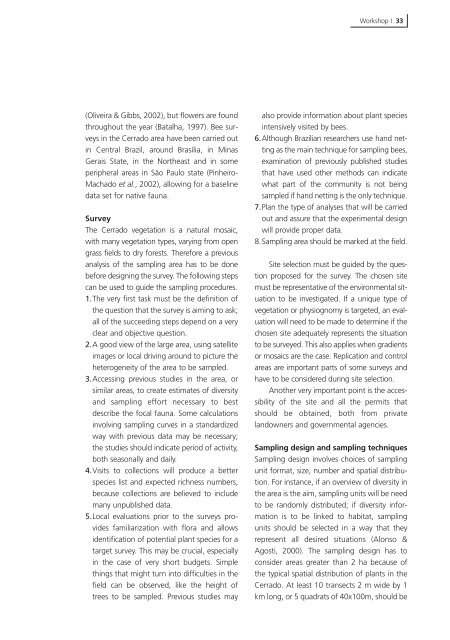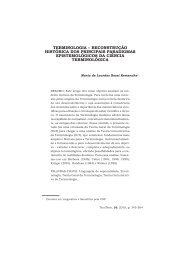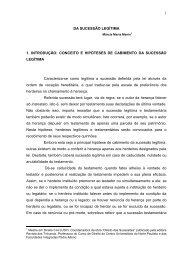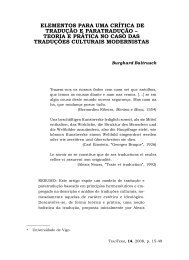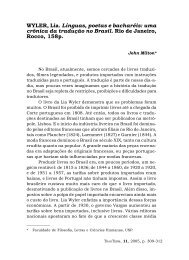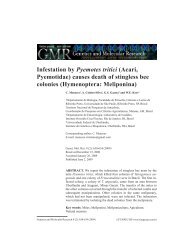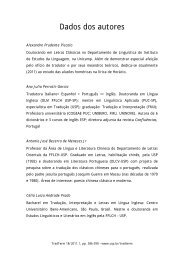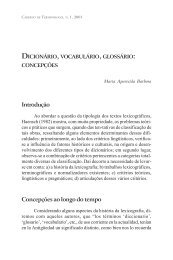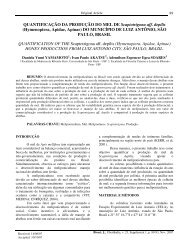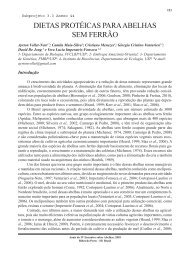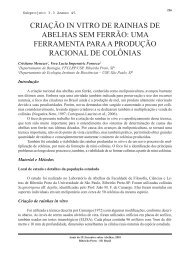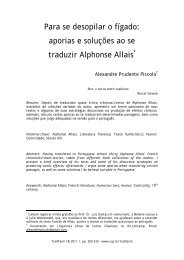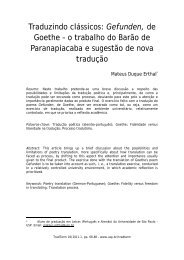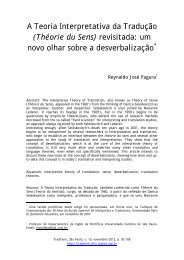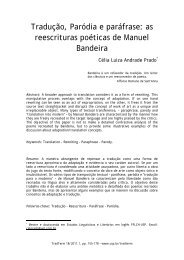Bees as pollinators in Brazil - USP
Bees as pollinators in Brazil - USP
Bees as pollinators in Brazil - USP
Create successful ePaper yourself
Turn your PDF publications into a flip-book with our unique Google optimized e-Paper software.
(Oliveira & Gibbs, 2002), but flowers are found<br />
throughout the year (Batalha, 1997). Bee surveys<br />
<strong>in</strong> the Cerrado area have been carried out<br />
<strong>in</strong> Central <strong>Brazil</strong>, around Br<strong>as</strong>ília, <strong>in</strong> M<strong>in</strong><strong>as</strong><br />
Gerais State, <strong>in</strong> the Northe<strong>as</strong>t and <strong>in</strong> some<br />
peripheral are<strong>as</strong> <strong>in</strong> São Paulo state (P<strong>in</strong>heiro-<br />
Machado et al., 2002), allow<strong>in</strong>g for a b<strong>as</strong>el<strong>in</strong>e<br />
data set for native fauna.<br />
Survey<br />
The Cerrado vegetation is a natural mosaic,<br />
with many vegetation types, vary<strong>in</strong>g from open<br />
gr<strong>as</strong>s fields to dry forests. Therefore a previous<br />
analysis of the sampl<strong>in</strong>g area h<strong>as</strong> to be done<br />
before design<strong>in</strong>g the survey. The follow<strong>in</strong>g steps<br />
can be used to guide the sampl<strong>in</strong>g procedures.<br />
1.The very first t<strong>as</strong>k must be the def<strong>in</strong>ition of<br />
the question that the survey is aim<strong>in</strong>g to <strong>as</strong>k;<br />
all of the succeed<strong>in</strong>g steps depend on a very<br />
clear and objective question.<br />
2.A good view of the large area, us<strong>in</strong>g satellite<br />
images or local driv<strong>in</strong>g around to picture the<br />
heterogeneity of the area to be sampled.<br />
3.Access<strong>in</strong>g previous studies <strong>in</strong> the area, or<br />
similar are<strong>as</strong>, to create estimates of diversity<br />
and sampl<strong>in</strong>g effort necessary to best<br />
describe the focal fauna. Some calculations<br />
<strong>in</strong>volv<strong>in</strong>g sampl<strong>in</strong>g curves <strong>in</strong> a standardized<br />
way with previous data may be necessary;<br />
the studies should <strong>in</strong>dicate period of activity,<br />
both se<strong>as</strong>onally and daily.<br />
4.Visits to collections will produce a better<br />
species list and expected richness numbers,<br />
because collections are believed to <strong>in</strong>clude<br />
many unpublished data.<br />
5.Local evaluations prior to the surveys provides<br />
familiarization with flora and allows<br />
identification of potential plant species for a<br />
target survey. This may be crucial, especially<br />
<strong>in</strong> the c<strong>as</strong>e of very short budgets. Simple<br />
th<strong>in</strong>gs that might turn <strong>in</strong>to difficulties <strong>in</strong> the<br />
field can be observed, like the height of<br />
trees to be sampled. Previous studies may<br />
Workshop I 33<br />
also provide <strong>in</strong>formation about plant species<br />
<strong>in</strong>tensively visited by bees.<br />
6.Although <strong>Brazil</strong>ian researchers use hand nett<strong>in</strong>g<br />
<strong>as</strong> the ma<strong>in</strong> technique for sampl<strong>in</strong>g bees,<br />
exam<strong>in</strong>ation of previously published studies<br />
that have used other methods can <strong>in</strong>dicate<br />
what part of the community is not be<strong>in</strong>g<br />
sampled if hand nett<strong>in</strong>g is the only technique.<br />
7.Plan the type of analyses that will be carried<br />
out and <strong>as</strong>sure that the experimental design<br />
will provide proper data.<br />
8.Sampl<strong>in</strong>g area should be marked at the field.<br />
Site selection must be guided by the question<br />
proposed for the survey. The chosen site<br />
must be representative of the environmental situation<br />
to be <strong>in</strong>vestigated. If a unique type of<br />
vegetation or physiognomy is targeted, an evaluation<br />
will need to be made to determ<strong>in</strong>e if the<br />
chosen site adequately represents the situation<br />
to be surveyed. This also applies when gradients<br />
or mosaics are the c<strong>as</strong>e. Replication and control<br />
are<strong>as</strong> are important parts of some surveys and<br />
have to be considered dur<strong>in</strong>g site selection.<br />
Another very important po<strong>in</strong>t is the accessibility<br />
of the site and all the permits that<br />
should be obta<strong>in</strong>ed, both from private<br />
landowners and governmental agencies.<br />
Sampl<strong>in</strong>g design and sampl<strong>in</strong>g techniques<br />
Sampl<strong>in</strong>g design <strong>in</strong>volves choices of sampl<strong>in</strong>g<br />
unit format, size, number and spatial distribution.<br />
For <strong>in</strong>stance, if an overview of diversity <strong>in</strong><br />
the area is the aim, sampl<strong>in</strong>g units will be need<br />
to be randomly distributed; if diversity <strong>in</strong>formation<br />
is to be l<strong>in</strong>ked to habitat, sampl<strong>in</strong>g<br />
units should be selected <strong>in</strong> a way that they<br />
represent all desired situations (Alonso &<br />
Agosti, 2000). The sampl<strong>in</strong>g design h<strong>as</strong> to<br />
consider are<strong>as</strong> greater than 2 ha because of<br />
the typical spatial distribution of plants <strong>in</strong> the<br />
Cerrado. At le<strong>as</strong>t 10 transects 2 m wide by 1<br />
km long, or 5 quadrats of 40x100m, should be


